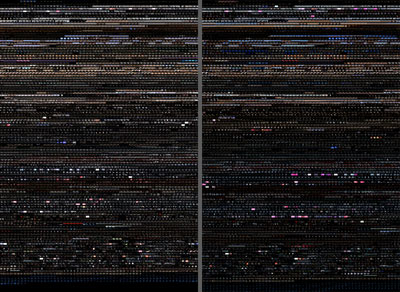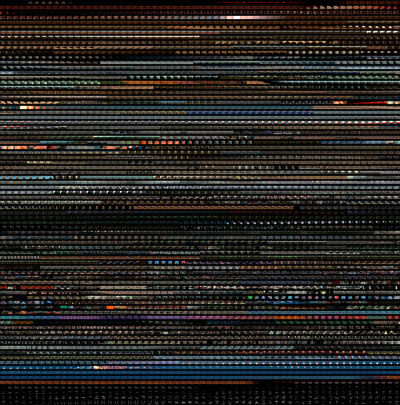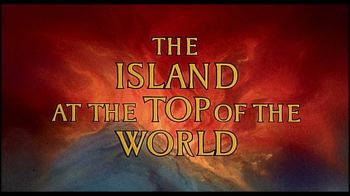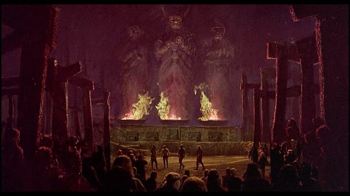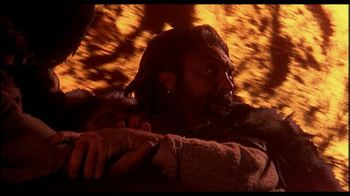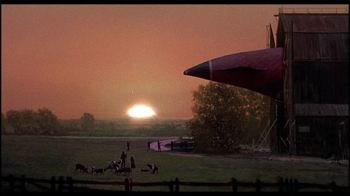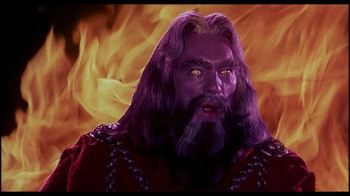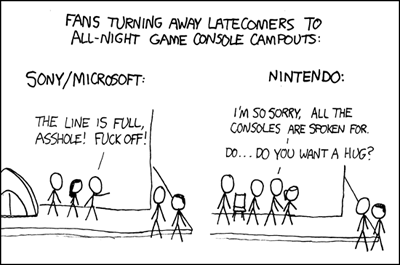Star Wars: Original Version vs Special Edition
I know it’s Star Wars, but… oh look, I just had to, okay?
With movies laid flat like this, it’s very easy to see how movies are structured. Much easier than actually watching them as movies. Now, this lead to a question: how are different versions of the same movie constructed? For example, how is Apocalypse Now structured compared to Apocalypse Now Redux? How does the American release of The Shining compare to the European version? Or, better still, just exactly how “shot for shot” was Gus Van Sant’s remake of Psycho?
Let’s start on an easy one: Star Wars.
(click on image for higher-res version - 1940 * 1416 px, 1.1MB)
Strangely, for all his fucking about, Lucas has kept the structure remarkably intact. For most of the run-time, the two movies track each other pretty well, being only a few seconds out of sync. It’s not until the second half when they really start to diverge. But even still, the Special Edition is only a couple of minutes longer than the original version. Which is odd, because the Special Edition felt like it was a lot longer.
I also like the colours in the special edition. The faded pastel colours of the original are nice and all, but are definitely improved with a bit of spit and polish.
Not sure about the change of colour in the scene with Luke looking at the two suns though.
# Jan 5, 2007Koyaanisqatsi
When movies are torn apart and stitched back together like this, it lets you see the movie with a completely different perspective. Presenting them as one flat image, rather than a fast-moving sequence of images essentially allows one to, uh… ‘see through time’, so to speak. The editing is torn apart and the pacing of the movie is laid bare, for all to see.
Koyaanisqatsi (an old favourite here at lowbrowculture) is a movie stripped to its fewest components. It is a movie that is all about the image and the editing. So that’s probably a pretty good place to start.
(click on image for higher-res version - 960 * 972 px, 416KB)
What I love about this movie and this set of images is just how perfect each shot is - each frame above could easily exist outside of the movie, like a perfectly-composed photograph.
# Jan 5, 2007New Project: Cinema Verite
I’m working on a new project: Cinema Verite.
Using processing (a powerful programming language with a lot of media capabilities), I’m ripping apart some of my favourite movies and putting them back together again. By taking screenshots at every second of the movie and laying them out flat - one image per second, sixty images per row - you get a completely different view of the movie.
So yeah, check it out, if you like that kind of thing.
# Jan 5, 2007Charlie Kaufman I'm not
I have been itching to do a screenwriting course for ages now. I’ve got a bunch of movie ideas that I don’t really… I don’t know, I don’t necessarily expect to do anything with them, but I want to get them out of my head, just so my brain isn’t cluttered with half-started/half-finished projects. The problem with the way I write, as you probably noticed, is that I find it hard to stay on one track for any length of time. Whenever I would start a screenplay, I would write the ideas I had in a half-assed way and then just hit a wall. I guess this stems from the way I come up with ideas for movies. For example, I want to write something called “JOHN STEELE DOESN’T KNOW HOW TO DIE”, but where the fuck do I begin?
So, after putting it off for months, I finally signed up for the filmbase course - “Screenwriting for Beginners”, which finished a couple of weeks ago.
I found the whole thing very useful. I learned all the sorts of useful ‘cheats’ to get you past the various stumbling blocks you’re likely to run into. Like how to flesh out your characters before you ever put pen to paper (or uh… fingers to keyboard) - useful because you know exactly how your characters will react in any situation you put them in. Or the other cheat of buying a book of baby names for when you find yourself struggling to find a decent name for your characters. (Which led to an interesting moment when I went into Waterstones to buy a book of baby names and got served by a friend of mine - so that’s what gobsmacked looks like).
And the tutor, Lindsay Sedgewick was friendly, helpful and knowledgeable. Whenever I gave her ideas for her to look over, she seemed to know exactly which bits I was unhappy with and always gave me useful suggestions for how to improve them. Although she did poo-poo one of my favourite ideas (involving a lost commune of hippies who have to re-join society after their crop of weed fails), but never mind.
So after finishing it, I started reading a few books on the subject: Joseph Campbell, Robert McKee, etc. So far, doing a good job of avoiding Syd Field. One of the books has really stood out for me: Blake Snyder’s “Save the Cat”. This one stands out because it doesn’t shy away from the ‘high concept’ side of screenwriting. In fact, for this book, the higher the concept, the better, as long as it sells. Which is just fine by us here on lowbrowculture.com. Unfortunately, his IMDB credits make it a little hard to take the whole thing seriously… would you take advice from the guy who wrote “Blank Check” and uh… “Stop, or my Mom will Shoot!”?
Ugh.
But seriously, any other potential would-be-but-not-really screenwriters out there on the interpod could do a lot worse than to check it out. Especially if you would rather be the next Shane Black than the next Wes Anderson.
Oh, and while you’re at it, you should check out Celtx, a free (as in ‘speech’) screenplay editor that is replacing Final Draft for a lot of people.
# Jan 5, 2007Thank Christ that's over

And so that’s another Christmas done and dusted. I hope everyone got what they wanted from Santa.
Except you fuckers who keep asking for “world peace.” Give it up. Quit deluding yourselves, it’s never going to happen. Just ask for a nice 42" Sony Bravia LCD TV instead.
# Dec 29, 2006Halo 3 Trailer
[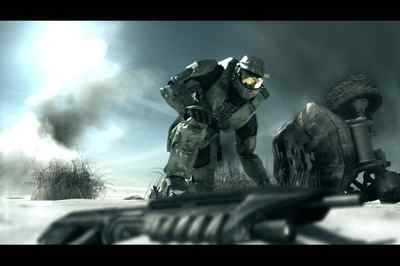 ](<a href=)
](<a href=)
The new CGI/live-action trailer for Halo 3 that ran during Monday Night Football in the USA hit the interpod yesterday. You can check out the crappy-quality Youtube version or download the high quality version from Xboxyde.
There’s something important to note about this trailer. This is less a trailer for “Halo 3” than it is for “Halo” as a brand. And there’s a real simple reason for this: it’s a dual purpose trailer. First, it’s meant to remind people of Halo’s (and Microsoft’s) relevance in a post-PlayStation 3 environment. And secondly, it’s meant to “sell” Halo to the movie studios after Universal and Fox got cold feet and pulled the plug on the Halo Movie. Before, they were being asked to put up $135m on a first-time director based on Peter Jackson’s word and they said “no”. Now they’re being asked to put up $135m based on a well-received, highly-polished trailer.
Let’s see if they’ll change their minds.
Update: I thought this trailer was directed by Neill Blomkamp, who was lined up as the director of the Halo movie before the plug got pulled. It was, in fact, directed by Joseph Kosinski, who previously directed the awesome, beautiful “Mad Love” trailer for Gears of War.
# Dec 6, 2006Embracing change
Over at thoughtwax, Emmet throws out a few ideas regarding emulation and how this fits with the Nintendo Wii’s Virtual Console functionality, which will allow you to download old NES, SNES, N64, Megadrive and PC Engine games from Nintendo’s online marketplace. He suggests that the return to simplicity shows that games are “maturing”.
Here’s what I think.
The Nintendo Wii is a console borne out of necessity. Compared to huge corporations like Sony and Microsoft, Nintendo just didn’t have the cash reserves necessary to compete properly in the ’next generation’ of game consoles. The console arms race had escalated to the point where failure for Nintendo could mean the end of the company. So what do they do? They bow out, go a completely different direction. Chase an entirely different market.
The point I’m trying to make here is that the Nintendo Wii is, by design, a ‘disruptive’ console, so it’s easy to interpret this as a sign of many things. But is it a sign that the industry is maturing?
Well, it means Nintendo is maturing as a business. With the weight of the failures of its last three (non-handheld) consoles straining the company’s relevance, it seems to be learning from its mistakes. But until we see how well the Wii is accepted by both the consumers and developers, it’s hard to say if this is any sign that the industry is maturing.
But what about the return to simplistic games? Does the kind of thoughtful reduction offered by the games from the Virtual Console mean that Nintendo is also maturing, drawing us into a new era of videogames? Are games entering their minimalist period?
Maybe not. Nintendo has fantastic first-party titles. In fact, it has traditionally had trouble securing third-party games because of the quality of its first-party titles. This means that the really quality games for Nintendo consoles come from Nintendo themselves and, given the length of time it takes to develop games, there could be months between ‘quality’ releases. Looking forward, and given the unusual nature of the Wii’s control system, there’s a definite possibility that there will not be a steady stream of games for the Wii for some time. We can see how the drought of games throughout the year affected the Xbox 360 sales. So Nintendo did the only smart thing they could: they plundered their back-catalogue for their Virtual Console. This does two things - one, it gives them an instantly available source of games for their new machine and two, it gives them a way to constantly release ’new’ games to their customers.
But the games that you play on the Virtual Console will be pixel-perfect versions of the games you played on your NES, SNES, N64, Megadrive or PC Engine. As the man says: Nothing added, nothing taken away. This shows no more maturity than the PlayStation 3’s ability to play games from PlayStation 1. Or the Xbox 360’s ability to play Xbox games. The only difference here is that PlayStation and Xbox’s disk-based formats have made it easy to provide backward compatibility to their last consoles whereas Nintendo’s ever-changing cartridge-based formats means people will have little choice but to buy up all their old games.
But think about Xbox Live Arcade. Like the Wii’s Virtual Console, it enables a player to download old arcade games and play them on their brand-new consoles. Except although nothing has been taken away, plenty has been added. For example, download Street Fighter 2 and you can play online against someone a thousand miles away from you. This, to me, is innovation. This, to me, is maturity. Accepting the on-line world and the way that games are more fun when they’re social (for an example of this, compare the experience of the two-player Live co-op version of Gears of War to the solo one-player version) shows more maturity than Nintedo’s apprach.
But I do think Nintendo are following the right path. I was completely wrong about the DS because I didn’t think its stylus control would be used. I couldn’t imagine the kind of innovation it brought about because I was thinking too small. Nintendo have capitalised on this. But will it succeed?
Perhaps Nintendo’s smartest move to date has been to make the Wii as underpowered as they needed. The low cost of manufacturing means that, should the Wii be a complete disaster, Nintendo can easily scrap the entire thing and start work on a new console. Compare this to Sony’s position - losing money, hand over fist, and based on a recent shake-up of key personnel in Sony Computer Entertainment, analysts predict there may be no PlayStation 4.
Consoles have always been a risky business (just ask Atari or Sega). And one thing is for certain: the games industry must mature or die. But this is easier said than done.
# Dec 5, 2006Away to Brussels
Herself indoors has been away in Brussels for some kind of conference or seminar or something (I wasn’t really paying attention) and so rather than have her come back here today, I decided to head over there and we could make a weekend of it.
Preparing for the trip has been rather disappointing. I used to think that the joke about Belgium being a really boring place was like the joke about the Irish being friendly. But it’s not a joke. Belgium seems to be a really, really dull place to go. Even the guidebooks don’t try to hide this. One of the “22 Things You Must Do in Brussels” is “Go to Antwerp”.
(aside: I wonder if the guide to Antwerp suggests going to Brussels)
# Nov 24, 2006Island at the Top of the World
Something I love about my family are the weird, idiosyncratic movies that have been with us for as long as I can remember. I’m sure your family has them too. The kinds of films that are almost a family institution, like the post-Christmas-dinner nap/singsong/fistfight, yet barely appear on anyone else’s radar.
For example, Murder She Said is a major deal within my family and this had a major impact on my development. Do you know what it’s like to be 6 years old and be able to rattle off every line of a 30-year-old black and white Miss Marple movie? Compare this with the kid in my class who knew every line of The Terminator and would frequently reenact the entire movie in school. I bet that guy is making millions now.
Then there’s also The Scarlet Pimpernel (starring a young Ian McKellan), which is a useful tool for defusing family arguments. When things start getting out of hand and everyone’s voices are booming a little more than they should, you just need to drop a mention of this movie and everyone’s eyes glaze over and a happy smile appears on their faces like their medication has finally kicked in. This is the film that taught me the cruel reality that videotape starts to really lose its quality after a couple of hundred viewings.
For me though, nothing can match The Island at the Top of the World. This movie had such a profound effect on my youth that it has become the yardstick by which all adventure movies are measured.
Rather than try to bluster my way through a summary of the story, here’s the blurb from the back of the box:
An American archaeology (David Hartman) joins a rich English businessman, an eccentric French inventor, and an Eskimo trapper (Mako, from Rising Sun), on an awe inspiring expedition to the Arctic. They're looking for a missing son, but they discover a world forgotten by time -- a world of 10th century Vikings, erupting volcanoes, and the legendary whales' graveyard.
The film itself has an impressive array of talent attached to it: directed by Robert Stevenson, who also directed many of Disney’s most popular live-action movies including Mary Poppins and The Love Bug, the screenplay was written by John Whedon, grandfather of Joss, and the music was composed by Maurice Jarre, father of Jean-Michel.
It’s not the cleverest movie you’ll see and at times it will push your suspension of disbelief to breaking point. But it’s a kid’s movie. Y’know… for kids! And that’s just par for the course for kid’s movies. Show me a kid’s movie that doesn’t require a conceptual leap of faith and I’ll show you one dull kid’s movie.
What makes Island at the Top of the World stand out is the charm with which it goes about telling its fantastic story and the spectacular, if slightly contrived set-pieces dotted throughout the movie. For example, at one stage, the characters outrun a flow of lava. If you leave your ‘real-world logic’ at the door and forget about things like “second degree burns”, this is a lot more enjoyable; after all, this is a Disney movie, and you’re only in trouble if the Lava actually catches you. As a child, this scene blew my mind and the sight of Donald Sinden being chased down by red-hot molten rock will stick with me forever.
And balls to people who complain about the special effects. More balls to people who try to give up excuses like “they were good for the time”. The effects in Island at the Top of the World are incredible. In terms of the the spectacle they create and the sense of scale they help achieve, it’s easy to look on Island at the Top of the World as some proto-Lord of the Rings. The sight of the airship (the Hyperion) coming out of its hanger is just one example. I almost had a fit when I saw Disney had recreated this image for a restaurant in Disneyland Paris.
Also, I have to question some of the so-called “mistakes” in the special effects. For instance, in a scene where the evil high priest is blue-screened in front of a giant fire, his blue eyes meant that you could see the flames in his eyes. Is this really a mistake? Or another kick-ass idea in a movie full of kick-ass ideas? I’m suggesting it’s the latter. If you pay close attention to this scene (and I have, believe me), you’ll see that this effect gets more pronounced as the priest gets angrier.
It’s almost a quarter-century since I first saw this movie. Watching it now is a weird experience. I used to know every line of this movie off by heart, but this useful knowledge has been buried under mounds of useless trivia (did you know you can tell a whale’s age by cutting its earwax and counting the rings?), so I get this weird, comforting, giddy sense of deja vu. Great times.
Now if you don’t mind, I think it’s time I watched this again.
Buy Island at the Top of the World on Amazon.co.uk
# Nov 22, 2006Continuing the theme of PlayStation violence...
Kottke spends some time thinking about the differences in the launches of the PlayStation 3 and the Wii and concludes that the violence and hysteria that surrounded the PS3 launch was due to the fundamental philosophical differences between the two systems - PlayStation is about aggression and competition, Nintendo is about fun and hugging.
Well, I’m sure that was a part of the reason, but I think there was a much simpler reason: greed.
This week’s 1up show has interviews with people in the PlayStation queue outside San Francisco’s Metreon. From the sample that they interviewed (that made it onto the show), the majority of people queuing up either didn’t know or didn’t care about the PlayStation 3. What they cared about was the profit they would make by selling this on eBay - some PlayStations have sold for $20,000, a remarkable 2300% profit. One gent informed the crowd how he “would rather fight, go to jail, than let someone cut in front of [him]”. Asked if he was buying the PlayStation to, y’know, play it? “Man, people are buying this to put it on eBay and cash out!”. And this guy wasn’t just buying one. He had people in lines all over, and he was going to sell them all. Except for the one he was “going to give to a poor family” (‘poor family’ with a hi-def TV?).
And the attach rates mostly support this. Of the 81,639 consoles sold in Japan, only 66,684 were sold with games. Sure, the PS3 has online functionality and you can download demos, but come on - you’ve just dropped seven hundred lids on this new, awesome piece of games hardware, you’re not going to get something that really shows it off?
But it’s not all so cynical. My favourite interviewee in the 1up show explained how he was an Xbox man and was loving Gears of War, but his girlfriend wouldn’t let him buy a decent Hi-Def TV to play it on. His solution was to queue up for a few hours, buy a PlayStation 3, sell it on eBay and buy himself a Hi-Def TV with the profits. I feel your pain, buddy.
I doubt this kind of mercenary greed would work in Ireland. The supply will be just as short here, but will the scalpers be making as much of a profit? I doubt it. It hardly seems worth it, unless you just get a kick out of depriving people of something they want and watching their misery. And if that’s your kind of thing, here’s a video of someone smashing a brand-new PS3 in front of queuing fans. Enjoy!
# Nov 20, 2006